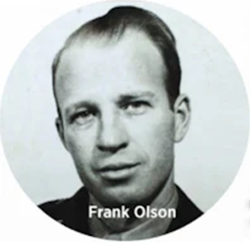Nov. 28, 1953: LSD and the death of a CIA scientist

Frank Olson. Photo by Beckman/Contributor
The mystery began in the early morning hours of Nov. 28, 1953, soon after Frank Olson plunged onto the pavement in front of New York City’s Hotel Statler.
Two decades later, the mystery surrounding Olson’s death would result in a lawsuit, a presidential apology and a six-figure settlement.
When police entered Olson’s room on the 10th floor above his battered body, they found a man sitting on the toilet.
The man on the toilet, a Defense Department chemist named Robert Lashbrook, said Olson was a bacteriologist and a colleague. He said he had accompanied Olson to New York City, where Olson was being counseled for severe depression. After the two had dined that evening and watched TV, Olson washed his socks in the sink and went to bed. At 2:25 a.m., Lashbrook awakened to a loud crash; he noticed that a window was broken—and Olson was gone. While being questioned, Lashbrook was asked to empty his pockets, and police found a CIA security pass. Lashbrook asked that they keep such details confidential as a matter of national security.
Unmentioned was the fact that Olson—43, married and a father of three—was more than just a bacteriologist. He was a specialist in germ warfare, specifically the airborne distribution of biological germs. He and Lashbrook were part of MK-ULTRA, a classified program at Camp Detrick in Maryland engaged in the research, development and testing of virtually every conceivable form of unconventional weaponry—whether biological, psychological, chemical or physical.
Also unmentioned was that nine days earlier, 10 CIA scientists had gathered at a cabin at Deep Creek Lake in western Maryland. There, Lashbrook—without warning—served an after-dinner liqueur spiked with lysergic acid diethylamide: LSD. The experiment was intended to test whether these key scientists might reveal, under similar duress, the secrets behind their decades of potentially scandalous research. To assure that he wouldn’t, Olson had been, in effect, under escort as his LSD-triggered depression was being treated in New York, not by a psychiatrist but by an allergist who had conducted LSD research while under contract with the CIA.
Even before the creation of the CIA in 1947, research into biological and chemical warfare was regarded as an evil necessity within the budding defense intelligence complex. Cold War rumors of “brainwashing” by communist governments fueled boundless experimentation by the CIA, which tested the tolerance of human beings—foe or friend—to torture, disease, chemical toxicity and, increasingly, psychological manipulation.
Bankrolled by the CIA through government grants and shell corporations, MK-ULTRA scientists tested toxic tools and mind-altering substances at secret foreign “safe houses” and domestic labs on sometimes unsuspecting human subjects: drug addicts, prisoners, random victims and, on occasion, each other.
After fruitless testing of street drugs, prescription pharmaceuticals and exotic hallucinogens—Lashbrook and his CIA supervisor, Sidney Gottlieb, settled on LSD as a potentially game-changing tool for interrogating, manipulating, debilitating or simply discrediting agency targets. That these experiments were dangerous, unethical and illegal was acknowledged within the agency. The response was to cloak them in secrecy.
Details become public
Though widely rumored inside the CIA, the link between MK-ULTRA experimentation and Olson’s death went unacknowledged until it was mentioned in 1975 by the Rockefeller Commission, a panel designated to investigate agency excesses following Watergate. But it was the so-called Church Committee—a subsequent Senate investigation documenting CIA involvement in foreign coups, assassinations and bungled intelligence adventures—that exposed the details surrounding Olson’s death.
The Church investigation also revealed that Gottlieb, upon leaving the CIA in 1973, had destroyed nearly all the agency records involving MK-ULTRA. And members of the Olson family, who no longer believed Olson died by suicide, announced a decision to file a lawsuit against the agency to force their own inquiry into its simplistic account of Olson’s plunge.
Their threat proved effective. On July 21, 1975, President Gerald Ford met with the Olson family at the White House, where he formally and publicly apologized for the government’s role in Olson’s demise. In a settlement authorized by Congress, the Olson family received $750,000 in exchange for dropping their legal claims.



